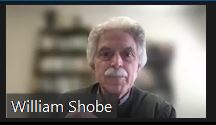Virginia and Climate Change – Zero Carbon Emissions by 2050
 William Shobe, a professor at the Weldon Cooper Center for Public Policy at the University of Virginia and director of the Center for Economic and Policy Studies, reported on what studies tell us about the likely technology mix needed for a transition to carbon neutral by 2050, and the likely costs and benefits of getting there. Some of these studies model decarbonization of just the electricity sector, commensurate with the requirements of the Virginia Clean Economy Act, while others look at economy-wide decarbonization. He also discussed some of the key roadblocks that need to be addressed if the decarbonization goals are to be achieved at a reasonable cost. The program was moderated by Bob McGrath, past SSV president.
William Shobe, a professor at the Weldon Cooper Center for Public Policy at the University of Virginia and director of the Center for Economic and Policy Studies, reported on what studies tell us about the likely technology mix needed for a transition to carbon neutral by 2050, and the likely costs and benefits of getting there. Some of these studies model decarbonization of just the electricity sector, commensurate with the requirements of the Virginia Clean Economy Act, while others look at economy-wide decarbonization. He also discussed some of the key roadblocks that need to be addressed if the decarbonization goals are to be achieved at a reasonable cost. The program was moderated by Bob McGrath, past SSV president.
The virtual session was recorded and the video can be seen here: https://youtu.be/kbYp674SF8M
Below is a podcast of the session.
Program Summary
 Professor Shobe spoke on the energy transition initiative that Virginia reduce electricity carbon emissions to net zero by 2050 and the pathways to reach this goal cost effectively. He discussed not only the opportunities to accomplish this, but also the roadblocks to getting there.
Professor Shobe spoke on the energy transition initiative that Virginia reduce electricity carbon emissions to net zero by 2050 and the pathways to reach this goal cost effectively. He discussed not only the opportunities to accomplish this, but also the roadblocks to getting there.
In 2006 Virginia reached the peak of carbon emissions and there has now been a considerable drop off. The reason behind this decline is the decrease in coal use and the increase in natural gas. After years of minimal usage of renewable energy sources, there is now a growing interest in hydro, solar and wind energy production. Since 2010 the importation of electricity into Virginia has decreased reducing carbon emissions. Since 2016 solar production has become increasingly popular. Currently the cheapest new resource to build is solar. In 2021 Virginia has produced the same amount of energy from solar as coal.
It was noted that the planning of these solar projects all started before the Clean Air Act was passed.
Professor Shobe stressed the importance of regional cooperation. Virginia belongs to PJM (named for the first three participating states, Pennsylvania, New Jersey, and Maryland) a group that shares energy consisting of neighboring states. East coast states developing offshore wind energy will have to work together as well as local and state governments needing to develop policies to encourage building of new facilities. To the last point, for local governments to be willing to support new plants, they want to be able to tax at the same rate as other development projects, not the current reduced rate.
The biggest roadblocks to reaching the 2050 goal are reducing carbon emissions in transportation, buildings, and industrial. Progress has already been made as in decarbonizing electricity.
Professor Shobe is hopeful that costs will come down in some energy sectors and new technologies will be available to make products more affordable. In the end, he feels with advance planning and cooperation a zero-carbon emission goal may be accomplished.
